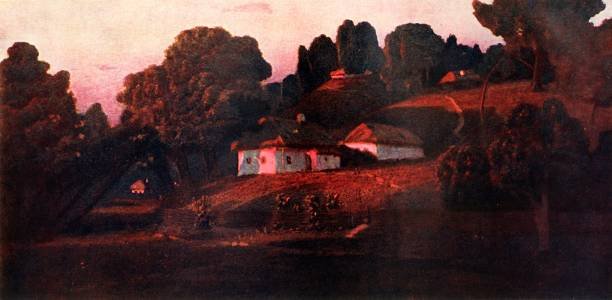In all the terrible news coming out of Ukraine a small article about Mariupol caught my eye recently. It mentioned that one of the buildings damaged by shelling was the Kuindzhi Art Museum and reported that some art works had been looted by Russian troops.
My mind immediately raced back to an exhibition of Russian landscape art at the National Gallery in 2004 in which I first came across the work of Arkhip Ivanovich Kuindzhi (1842-1910). I was really taken by it and did my best to find out about him in my frequent subsequent trips to Russia. I’d also been reading up on the Russian mystic/philosopher/artist (and, some say, spy) Nikolai Roerich. On a visit to the Roerich Museum in Moscow as I peered closely at an old photo of Roerich’s art class I realised with a bit of a shock that his tutor was….yes, Arkhip Kuindzhi. All of this clearly required more investigation and I spent some time finding out about the two of them. This was all twenty-odd years ago and I have had several reproductions of Kuindzhi’s work and one of Roerich’s hanging in our house ever since. My researches didn’t lead very far though. There is quite a bit on Roerich in English but Kuindzhi hardly gets a look in even though he was a very popular artist in his day and his work is still of some standing. Browsing the net, I noticed in a recent Sotheby’s sale that one of his paintings sold for around $3million.
Kuindzhi was an absolute master of illumination – both by sun and moon.
Moonlight on the Dnepr. 1880.
Ukraine Evening. 1878-1901. Russian State Museum, St. Petersburg.
Morning on the Dnepr. 1881. Tretyakov Gallery, Moscow.
What attracts me most is not his technique though but the suggestion of emptiness and presence at the same time – that spaciousness which borders on the spiritual. ‘Morning on the Dnepr’ is a painting almost of nothing.
I’ve always been particularly struck by this one below, too. It is one of several he painted which carry the title “Birch Grove”. Am I the only one to see a very definite suggestion of a split down the centre of the painting – almost a rent in reality? It is a little exaggerated by the colour tone in this reproduction but I have seen the original and it is definitely there, believe me.
Birch Grove. 1879. Tretyakov Gallery, Moscow.
There is very little written about Arkhip Ivanovich Kuindzhi in English – that I have ever found anyway. He is not even mentioned in Honour and Fleming’s World History of Art. In other sources he is simply referred to as a Russian artist. I’d have to be honest and say that until recently I wouldn’t have quibbled with that. Despite my interest I had never even heard of the Kuindzhi Art Museum. Now it is brought to my attention in the worst of circumstances. And it dawns on me why it is in Mariupol. It is in Mariupol because, as I now remember, that is where Kuindzhi was born. He was Ukrainian.* At the time the Crimea was part of the Russian Empire so perhaps there was some justification for calling him Russian. The distinction might have passed most of us by once upon a time, but not any more.
Here’s my homage to to Arkhip Ivanovich – my own little birch grove a short walk from our house. (Taken coincidentally with a Russian Zorki 4K.)
* Kuindzhi is not on his own either. Vasily Grossman, author of Life and Fate and often referred to as Russian was also born in Ukraine - as was Mikhail Bulgakov, author of The Master and Margherita. I wonder how many others there are?













